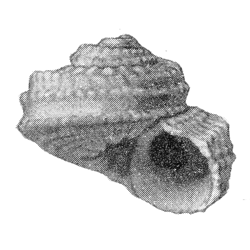
Liotiidae

- Phylum: Mollusca
- Class: Gastropoda
- Order: Trochida
- Family: Liotiidae
Overview
Common Name: Liotia shells
Key morphological features: The Liotiidae are small gastropods with planispiral, conispiral, or rounded, turbinate shells. Liotiid shells are often umbilicate, lack siphonal canals, and are low-spired. The shell exterior is rarely smooth, with most species exhibiting spiral and/or axial sculpture, including beaded or smooth spiral cords, and/or small, scaly or large, triangular spines. The aperture is circular or subcircular, frequently with a thickened labrum. Sources: Davies, A.M. 1971. Tertiary Faunas Vol. 1, second edition. New York: American Elsevier Publishing Company, Inc. 571 pp.; Tunnell Jr., J.W., Andrews, J., Barrera, N.C., Moretzsohn, F. 2010. Encyclopedia of Texas Seashells. College Station: Texas A&M University Press. 512 pp.
Geological range: Triassic to Recent (Davies, 1971).
Geographic distribution: A distributional map for modern Liotiidae may be accessed from OBIS. A distributional map for ancient Liotiidae may be accessed from the Paleobiology Database.
Diversity: There are 105 recognized living species of Liotiidae and 16 genera (WoRMS database, unvetted). The Paleobiology Database recognizes 17 fossil genera and 71 fossil species of Liotiidae (unvetted).
Paleoecology: The extant Liotiidae are epifaunal, grazing, marine gastropods. They are found predominantly in hard substrate habitats in warm, shallow waters worldwide, although some species are known from deep and cold waters. Sources: Tunnell et al. (2010); OBIS; Paleobiology Database
Phylogenetic status: Paraphyletic. The molecular phylogenetic analysis of Williams and Ozawa (2006) supports the paraphyly of Family Liotiidae.
